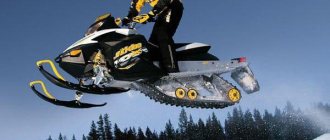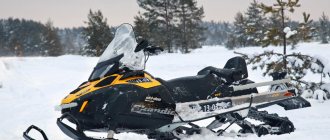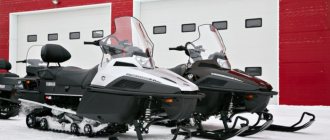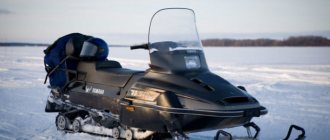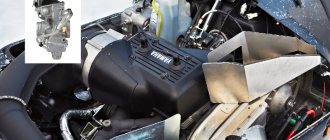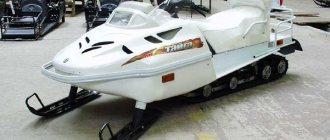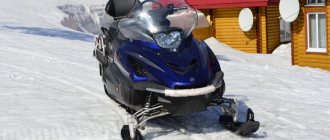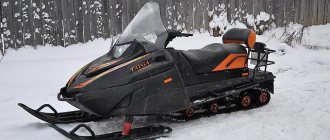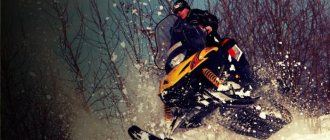Where a person cannot go, the Yamaha Viking VK 540 V snowmobile will more than pass. Good cross-country ability, high-quality control, improved traction capacity - all these advantages make the Yamaha a good assistant in especially snowy places. You can purchase a snowmobile from a company that is an official dealer of Japanese manufacturer products in different cities of the country, or from individuals.
The snowmobile has received new parts: the suspension has new settings, the exterior has changed. To improve the responsiveness of control and the efficiency of movement, manufacturers have built a high-power engine into the Yamaha Viking 540 snowmobile, and the stroke of the hydraulic shock absorber located in the front has been changed - it has been increased to 150 mm. All these additions are integrated into a fundamentally new version of the Yamaha snowmobile, which guarantees effective protection for passengers and the driver. You can check the price and conditions for purchasing on credit in the store on the official website.
TOP 9 snowmobiles of the Yamaha model range and their characteristics
In 2010, a new and improved model, the Yamaha Viking 540 III, entered the market. Its capabilities have received the best ratings from ordinary users and professionals.
This snowmobile will undoubtedly become a faithful assistant. He is strong and very pliable.
It has already received high marks from residents of the north and hunters, who were able to fully experience the benefits of the Yamaha Viking 540 III.
It has a 535 cc 2-stroke engine with a power of 53 horsepower.
It is air-cooled, and the snowmobile itself weighs less than similar 4-stroke counterparts. The chassis is durable.
Considering utilitarianism
Reverse gear is standard on high/low gearboxes
Since the Yamaha RS Viking Professional snowmobile was designed as a utilitarian snowmobile, it is equipped with Yamaha's most advanced 4-stroke engine. The Genesis 120 was designed specifically as a snowmobile engine, i.e. with high torque and high efficiency due to the fuel injection system. The air-cooled Viking 540 engine also has plenty of torque, but being a 2-stroke, it tends to gradually lose power once it reaches its mid-range level. The 4-stroke RS Viking Professional pulls three times longer, peaking at around 8200rpm, making it an excellent replacement for the VK 540. And although the liquid-cooled engine has a relatively high 11.3 compression ratio, it runs just fine on regular 87-octane petrol.
Suspension:
The device, as it turned out, confidently holds a high-speed straight line, perfectly absorbs bumps in compacted snow and simply does not react to either longitudinal or transverse ruts left after dozens of previous races. Coupled with an increase in the volume of the fuel tank from 40 to 44 liters, this can give a noticeable increase in the autonomy of the machine, which is very important for a workhorse.
Technical characteristics of the Yamaha Viking Professional • Snowmobiles from yamaha
In addition, the products from this company are distinguished by a peculiar charm that is hardly inherent in any other vehicles for traveling on snow. to ensure maximum controllability on any surface, including on ice, because the skis are equipped with special optimized skates;.
| Technical characteristics of Yamaha Viking (Yamaha Viking) 540 IV | |
| Dimensions, mm | 3055 / 1190 / 1355 mm |
| engine's type | two-stroke |
| Working volume, cubic meters cm | 535 |
| Cooling | air, axial fan |
| Transmission | YVXC, stepless, 2 forward + reverse |
| Front suspension | telescopic stand |
| Front suspension travel, mm | 150 |
| Rear suspension travel, mm | 385 |
| Track type, width, mm | 3922 / 508 / 35 mm |
| Fuel tank capacity, l | 31,0 |
CITD-3 (with spark plug sensors)
Ts ITD 3 is a digital temperature indicator for a snowmobile that displays the operating temperature of the engine using two ring temperature sensors under the spark plugs. The kit of CITD 3 includes everything necessary for its installation. Differences between TsITD 3 and its predecessor TsITD 2-1: cylindrical body shape with reduced dimensions L 65 mm, D 54 mm and improved design; increased tightness; The internal electrical part of CITD 3 is made more reliable. CITD 3 is a third generation device - a new product on the market. You can get acquainted with the CITD-3 device in the article “Improved Engine Temperature Indicator “CITD-3” - review.” Read the article on how to install CITD 3 on a snowmobile
CITD 3 characteristics
- Operating temperature from - 50 to + 50 C.
- Power supply - constant or alternating 12 Volts.
- Temperature measurement error is no more than 2 C.
- Temperature measurement range from - 50 to 199 C.
- The overheat warning threshold is 196 C + - 2 degrees.
- Passport/installation manual - 1 pc.
- Measuring unit - 1 pc.
- Wiring - 1 pc.
- Wiring fastening clamp - 2 pcs.
- Outdoor temperature sensor - 1 pc.
- Engine temperature sensor - 2 pcs (for spark plugs).
- Button for switching air temperature readings to engine temperature.
Technical characteristics and price. Vk540 iv 2012-2015
| Yamaha Viking Professional: technical characteristics, engine power, maximum speed, operation and maintenance features, owner reviews The massiveness and large dimensions of the snowmobile's design are due to the front section of the Deltabox, thanks to which the transmission is located behind and below the center line of the runners. Using the hood cover as an example, you can see that all other body panels of the snowmobile were created taking into account aerodynamic parameters; for this, in fact, the car was blown in a wind tunnel. |
- electric starter;
- reverse;
- heated steering wheel and accelerator lever;
- halogen lamp 60/55W.
Technical characteristics • The track base of the snowmobile is 508 millimeters.
Oil selection and change
It is recommended to use Motul oil for two-stroke engines, and Snow Power SAE OW-40 for four-stroke engines.
In order to change the oil on a snowmobile, you must:
- Warm up the power unit to operating temperature.
- Remove the rear side part.
- Raise the front of the vehicle using a jack.
- Unscrew the screws under the hexagon.
- Remove the battery, air filter element and battery bracket.
- Visually inspect the O-ring for damage and wear. If necessary, replace the part with a new one.
- Drain the old oil fluid.
- Drain the transmission oil.
- Install a new filter and screw it to the engine.
- Add oil.
- Screw on the lid.
- Install all mechanisms in place.
Dimensions of the Viking 540 model snowmobile
It is noteworthy that this device was produced for about ten years, and during this time this snowmobile underwent almost no changes, and at the same time remained popular. The new VK540V, more economical and meeting the latest environmental standards, has an even more powerful engine and a new track with 1.5-inch lugs.
Installation of temperature sensors in the engine head, general recommendations
Installing temperature sensors in engine heads is not difficult. To install sensors without removing the cylinder heads from the engine, it is necessary to determine in advance where the recesses will be prepared. For example, by examining an analogue head in a store. When drilling a recess for the sensor, use a drill with a diameter 2-3 hundred parts larger than the diameter of the sensor and do not drill through the head! The minimum is considered to be a recess in which the sensor is placed at a height of at least 7 mm (applies to a kit sensor). In this case, a cambric should be placed on the protruding part of the sensors, depriving the sensors of airflow. The ideal option is that the sensors are completely immersed in the body of the head and do not protrude outward. The advantage of this installation is that you install it once and forget it! There is no need to dismantle the sensors in the future, for example when replacing spark plugs, which means there is no risk of damage. The closer the sensors are located to the center of the heads, the more accurate the readings and the faster their change. We do not recommend installing sensors in the engine head, on the exhaust manifold side - the temperature will be too high.
The thickness of the head where the spark plug is mounted is usually equal to the length of the spark plug thread. Quite often, a recess for the sensor is drilled near the spark plug, so that the spark plug is located between the sensor and the fan. This method is correct - the sensor is as close as possible to the center of the head. If you use this method, make sure that when installing the spark plug, the key does not touch the sensor.
Before installing the sensor in the recess, the recess must be filled with KPT 8 thermal paste or similar. Thermal paste fills air gaps and promotes 99.9% of heat transfer from the head to the sensor. After installing the sensor, the edges of the recesses are slightly deformed by the core (it is not permissible to deform the sensors). This prevents the sensor from falling out.
Installing a temperature sensor in the head of a Buran snowmobile
In our opinion, this is not the best place for installation. With this installation of the sensor (from the exhaust side), the readings will be higher. It is clear that exhaust gases have significant temperatures. In addition, the sensor wires were left unprotected and very soon, due to vibration, they would lose their insulation from being closed. About how the kit works Moto thermometer on the Buran snowmobile
Installing sensors in the engine head of a Taiga snowmobile
The sensor installation location is selected in the stiffening rib of the engine head, running crosswise, from stud to stud. The thickness of the metal in this place is about 26 mm
Installing a temperature sensor on the Lynx snowmobile, similar to the installation on the Taiga snowmobile
Attention! On 2-cylinder engines, temperature sensors should not be installed, say only at the right studs (as in the photo below). This will lead to significant differences in readings, up to 30 degrees Celsius. The reason is quite simple - the installation location of one sensor is close to the fan and is very cool, the second sensor is installed almost at the epicenter of the heat. To avoid this effect, the sensors should have been positioned differently - the sensor of the left cylinder should be installed at the right stud, the sensor of the right cylinder - at the left, that is, opposite each other at the inner studs
Installation of temperature sensors in the Lynx snowmobile engine head is also possible in the technological holes available on the engine cylinders. As a rule, the holes need to be deepened
Operation in wet environments*
It is noted that when operating devices on equipment that is frequently exposed to moisture, oxidation of printed circuit boards may occur, followed by failure of electronic parts. This situation is faced by users who daily operate equipment in the cold - warm garage mode, or on the water (powerboats). It is quite easy to protect the device from moisture. It is necessary to cover the printed circuit boards with a protective compound that prevents exposure to moisture. Radio stores have a wide range of such products. Before applying the protective layer, wiping with pure alcohol is useful.
Don't forget to thank the author by clicking the rating button at the top of the page, or by posting a link to the article on the Internet. Thank you
Summary and reviews from owners Snowmobiles from Yamaha
| Buy a Yamaha RS Viking Professional snowmobile in Vladimir The Yamaha RS VK Professional snowmobile is equipped with a two-speed gearbox, allowing the snowmobile owner to use a lower gear to tow heavy loads at speeds less than 80 km per hour or a higher gear when there is no towed load. New, even wider blown skis, a whopping 3922 x 508 x 35mm Camoplast Ripsaw Full track, 7T external drive sprockets and a 2-speed transmission allow the new Viking 540 IV Limited to tow loads and tear through powder with ease. |
- Genesis® Mid Performance 3-cylinder, 4-stroke engine. The reliable, durable, fuel-efficient engine started the four-stroke snowmobile revolution. The classic three-cylinder engine with carburetor runs smooth as silk and handles any trail conditions well.
- Lightweight stamped pistons. The forged pistons used in the mid-duty engine are lightweight but allow a high compression ratio of 11.3:1 when using 87 octane gasoline.
- Gearbox with low and high modes and reverse gear. Yamaha RS VK Professional snowmobile is equipped with a two-speed transmission, allowing the snowmobile owner to use a lower gear when towing heavy loads at speeds less than 50 mph, or a higher gear when there is no towed load. Gears are changed using a lever located on the right side of the cab. The gear lever can also be used to engage reverse mode.
- Torsion bar rear suspension. The RS Viking Professional features an all-new rear suspension. This dual-shock torsion bar suspension is different from the ProAction . New 40mm rear shocks operate independently of each other with an emphasis on squat resistance. A larger diameter allows for greater resistance under the weight of the load. In fact, the entire suspension system has been recalibrated to match the spring rates at the raised rear of the track rails. The new connection improves the snowmobile's ability to reverse in soft snow conditions, allowing the snowmobile owner to engage reverse when off-piste without fear of the snowmobile becoming buried in the snow.
- New Camoplast® Ripsaw Full™ track. One of the main advantages of the Yamaha Viking Professional is the new Camoplast® Rip Saw™ track (20 x 156 inches) with a 1.375-inch lug height. The higher ridge allows for better acceleration in deep powder conditions and greater off-road performance. The large Rip Saw™ the VK Pro snowmobile
- 7T external gear sprockets for better traction.
- New wide Blow Mold skis with optimized skates. New super-wide plastic skis give the snowmobile excellent flotation in loose snow conditions and good turning ability.
- Ultra-rigid Deltabox™ chassis. Deltabox™ chassis design is designed to accommodate mid-range engines. They support the engine and, thanks to their special design, have earned a reputation as the stiffest chassis on the market. The stiffer the chassis, the more reliable the snowmobile is in use.
- The suspension's A-arms are curved in a gullwing design to provide maximum ground clearance. The second generation front suspension geometry features short steering knuckles and gullwing A-arms. The suspension has been designed to provide increased cornering stability and consistent torque throughout its travel. Vertical travel is 9 inches and ski distance is 47.2 inches. Handling remains stable thanks to a constant caster angle of 23°. Gullwing-shaped A-arms help avoid difficult collisions with obstacles hidden under snow.
- Underseat storage capacity and a strong, spacious external trunk. The RS VK Professional's seat folds upward to reveal a spacious luggage compartment located underneath. A set of tools is built into the compartment wall. Snowmobile users can store extra spare parts, a full set of tools and even their lunch in the under-seat compartment.
- Comfortable seat and high windshield. RS Viking Professional snowmobile can handle any job, no matter what it is. It is equipped with a large windshield that can protect both the driver and passenger from unwanted influences.
- Electrically heated steering wheel grips and accelerator trigger. The Yamaha RS Viking Professional snowmobile hand and thumb warmers consistently enjoy the reputation of being the best such devices in the entire industry. Control over them is carried out individually, by using the modes presented on the digital device so that the rider can easily see them. Owners of this sled can choose from 10 hand warmer settings and 10 thumb warmer settings, while other sleds on the market only have two heat settings: high and low. Passenger hand warmers are turned on and off using a separate switch.
- Towing device. At the rear of the Yamaha Viking Professional there is a towing device for towing loads. Snowmobile users can use this device to tow large loads in a towed sled.
- New running boards are spacious and grippy
Technical characteristics and price • various options for external tuning;.
Second problem of the Yamaha VK540 engine
Overheating due to air leaks, which occurs due to loss of elasticity of the crankshaft and intake pipe oil seals, as well as due to a clogged fuel filter. This leads to a “leaner” fuel-air mixture and an increase in the temperature of the exhaust gases. The quality of the mixture can be determined by the condition of the candles. A light candle is a poor mixture. Also, using a compression meter, you can determine the compression, which will indicate the condition of the cylinder-piston group. A compression value of less than 6 units indicates the need for engine repair.
Also, using spark plugs with the wrong heat rating leads to burnout of the piston group. For this motor it is necessary to install BR9ES. The use of candles with a low heat rating leads to “glow” ignition, that is, the mixture is ignited not by a spark, but by excessive heating of the candle itself. Incorrectly functioning spark plugs lead to increased fuel consumption, decreased engine power, and engine “tripleting.”
Chassis features
The snowmobile is able to move smoothly through snow 20 inches deep thanks to its massive and powerful 3,962 millimeter long tracks. They are driven by parallel suspension rails with an articulated rear section. Excellent snow traction is provided by the ProAction Plus suspension with an improved track. The rear suspension hinges give the track flexibility and minimize the appearance of deep ruts when reversing in deep snow. Owners of the Yamaha Viking Professional in their reviews note the usefulness and practicality of this function.
The massiveness and large dimensions of the snowmobile's design are due to the front section of the Deltabox, thanks to which the transmission is located behind and below the center line of the runners. The Yamaha Viking Professional uses a special tunnel to create enough space to accommodate the suspension and wide tracks. This design allowed engineers to install a wide and long seat and luggage compartment underneath.
The advantage of the Viking Professional snowmobile is the removable rear passenger seat, which, however, has long been standard for Yamaha snowmobiles.
Malfunctions and repairs
Main malfunctions and repairs of a Yamaha snowmobile:
- If the engine does not start, the cause of the breakdown may be pinched or clogged tubes or filter elements. In this case, it is recommended to disconnect the ends of the fuel pipes and carburetor system and blow them out. You should also wash the filter elements in fuel liquid.
- If the power unit operates intermittently, it is necessary to clean the spark plugs from accumulated carbon deposits and inspect the low voltage wires of the ignition system for defects.
- If you hear extraneous noise in the reverse box, you need to inspect the sprockets, gears and bearings for wear, and if necessary, replace the damaged mechanisms.
- If the variator belt slips, it is recommended to clean the surface of the disc elements and reduce the load on the vehicle.
- If oil fluid leaks from the reverse gearbox, it is necessary to check the shaft seals and, if necessary, replace the cuffs.
- If the variator does not change the speed, it is recommended to inspect the movable disks for jamming and replace worn liners of the coupling half and driven pulley.
- When oil fluid flows through the sprocket shaft sealing devices, worn rings need to be replaced.
- Excessive sprocket tooth wear may be due to excessive track tension or improper tooth alignment. In this case, worn or damaged sprockets should be replaced, tension adjusted, and the track belt centered.
- Stiff steering can be caused by stuck bushings in the bearings or steering gear. It is necessary to lubricate the bearings and working surfaces of the disk parts.
- If the brake system malfunctions, it is recommended to wash the pads and adjust the brake valves.
Features of Yamaha snowmobiles
The two-stroke, two-cylinder layout is compact and lightweight, which benefits a more rational organization of the engine compartment and also reduces the weight of the snowmobile. But there is another modified version that combines maximum reliability and affordable cost, namely the Yamaha Viking 540 IV Tough Pro snowmobile.
Major improvement
Turn the key to start all 120 Viking horses
The Yamaha RS Viking Professional snowmobile was a significant step forward from the already fading, but still very, very popular Yamaha Viking 540. The aluminum frame is lightweight thanks to Yamaha's patented Controlled Flow die casting technology, as a result, it became possible to produce thinner-walled and at the same time more durable parts. The engine is by far the major improvement, resulting in increased power and torque in the new RS Viking. But you will also undoubtedly discover that this new utility, despite its deceptive appearance, is quite sporty and capable of a very decent ride on the track, so you need to be an experienced rider to control it
Small snowmobile clubs need good, multi-purpose machines for rescuing stranded snowmobiles and their riders, maintaining tight access trails, or performing other necessary club work, and the Yamaha RS Viking Professional is the ideal choice. It's as reliable as the Yamaha Viking 540 it replaces. It has a durable front bumper, side mirrors and a standard tow bar. All this makes Yamaha's latest utility sled an excellent choice. And of course, you'll find that with triple the torque and A-frame front suspension, this sled will be much more popular in the clubs for everyday work.
Even more comfort Snowmobile is not for fun
| Review of the Yamaha Viking 540 snowmobile: equipment, advantages, owner reviews. The machine, although it had an impressive weight and price, gained incredible popularity among those who use snowmobiles for work often and in large quantities. Snowmobiles Yamaha Viking 540 4 rs Yamaha Viking Professional and snowmobile Stealth Viking 600 Name 540 Professional Stealth Fuel tank, liters 31 40 45 Fuel type Gasoline not lower than AI-92 Average consumption per 100 km, liters 30 30-40 30 Cost, thousand. |
- Genesis four-stroke, three-cylinder engine with a displacement of 973 cubic centimeters.
- Liquid cooling system.
- KEIHIN carburetor fuel system with liquid heating.
- Fuel tank capacity is 40 liters.
- Transistor ignition TCI.
- YVXC transmission with high and low gears.
- Brake system with mechanical parking brake, four-piston caliper and hydraulic drive.
- Independent front suspension with Gas Cell and Hydraulic shock absorbers.
- ProComfort rear torsion bar suspension with Piston shock absorbers.
- The length of the snowmobile is 3260 millimeters.
- Width - 1220 millimeters.
- Wide Blow Mold skis.
- Camoplast Ripsaw track.
- Weight - 360 kilograms.
What is the price
You can find out how much a Yamaha Viking 540 snowmobile costs and prices for spare parts on the official dealer website. You will learn more about buying a snowmobile on credit by submitting a request for a test drive. Specialists will advise customers free of charge on problems that relate to the purchase of a new VK540V model.
Model cost:
- IV – 400 thousand;
- IV – 350 thousand;
- III – 300 thousand;
A 1994 Yamaha Viking 540 E costs 240 thousand rubles.
The official Yamaha website invites owners to learn more about the snowmobile, read the VK540V instruction manual, and learn detailed specifications and conditions of use. The Yamaha Viking snowmobile will be an indispensable assistant that will cope with the transportation of goods and competitions in various sports.

